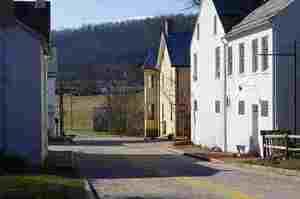Beginning of September the Built Environment Forum Scotland launched a microsite on small towns and a report that I have written about Scotland’s small towns. The report is based on “health checks” that I have carried out in six towns in different parts of Scotland. They are of various sizes, but all less than 40,000 people: Arbroath, Campbeltown, Dumfries, Elgin, Kilsyth and Stornoway. The health check covers the built environment; innovation; social cohesion and environmental sustainability. The full list is included as an Appendix in the report.
The “health checks” were undertaken with local government officials and councillors, traders and community representatives coming together to share ideas about their town. I then wrote a report on each town. Finally, the findings from the six visits have been drawn together to diagnose strengths and weaknesses and explore ways in which local stakeholders might work together to sustain their town.
Small towns are important but overlooked
While the cities are the main drivers of the economy in Scotland as elsewhere in Europe, the importance of the small towns can too easily be overlooked. Each of the six towns I visited has some innovative businesses that are operating in global niche markets. Ways need to be found to share the ethos and know-how of such enterprises with other local businesses, and to strengthen their links with local schools and colleges.
However, optimising the economic performance of a small town does not mean aping the cities. Rather each town needs to play to its own distinctive strengths. These are likely to include the quality of life that a small town can offer, particularly for families. A good environment, affordable housing, good schools and an active community all contribute to this.
Town centres under pressure
The challenges facing the centres of small towns are familiar ones. Thirty years of developing supermarkets on the edge of town have drained the life out of town centre retailing. Can anybody really be surprised? However, the issues are wider than retailing: for example, many of our towns have at their heart iconic public buildings that are either empty or struggling to establish viable new uses. Former churches, town halls and sheriff courts are examples. An active and imaginative conservation strategy is essential if the heart of these towns is to be saved.
The issue of parking is often controversial, with some traders believing that their survival may depending on people being able to park outside the shop for free for as long as they like. However, the competitive advantage that small town centres have today is their capacity to offer people a place to meet one another, share activities and access services –and all in an attractive environment. The quality of the place is part of the appeal, and is unlikely to be enhanced by cars filling prime sites. Social enterprises and community businesses are playing an increasing part in sustaining buildings and activities in our small town centres.
Public sector jobs
Public sector jobs are important in small towns. Particularly in the regional centres and more remote towns they are a vital source of professional career opportunities, which then generate income for spending on local services. Rationalisations of public service provision tend to concentrate schools and health facilities in larger centres. Withdrawal of such services and loss of local jobs means that some towns may face a spiral of decline. Loss of shops could be followed by loss of jobs and services, followed by loss of spending and people.
A town-focused and integrated approach
A town-focused approach is needed, but Scotland’s local government units are extensive and remote from the small towns. Small towns are not municipalities with their own elected mayors and councils. In rural areas the council typically is responsible for several small towns. The risk is that they then preside over an even-handed management of decline.
Ways have to be found for people who care about their town to come together, identify common aims, and the unique selling point of the place. Much could be done to strengthen the identities of small towns, and their branding. Not least, it’s time to engage the young people in developing and testing their ideas for the kind of town where they want to live and work. A health-check can be a catalyst for action.
Picture: Copyright fauxto_digit

